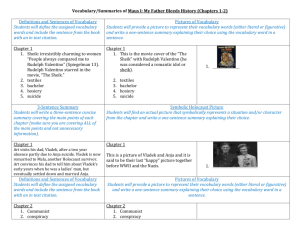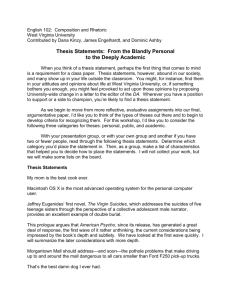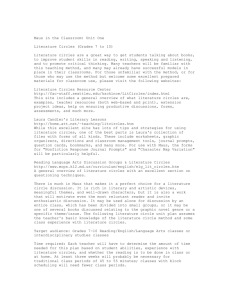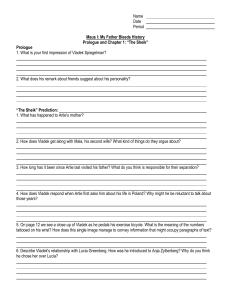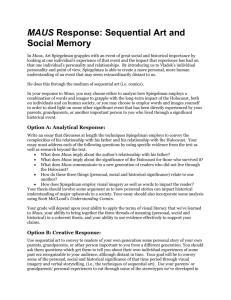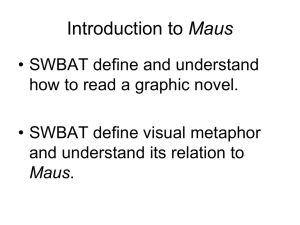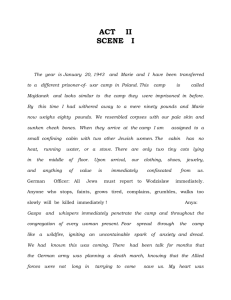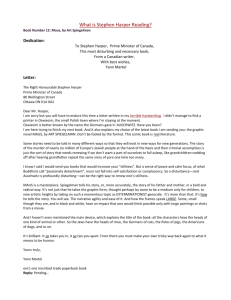Teaching Notes - Puffin Books Australia
advertisement
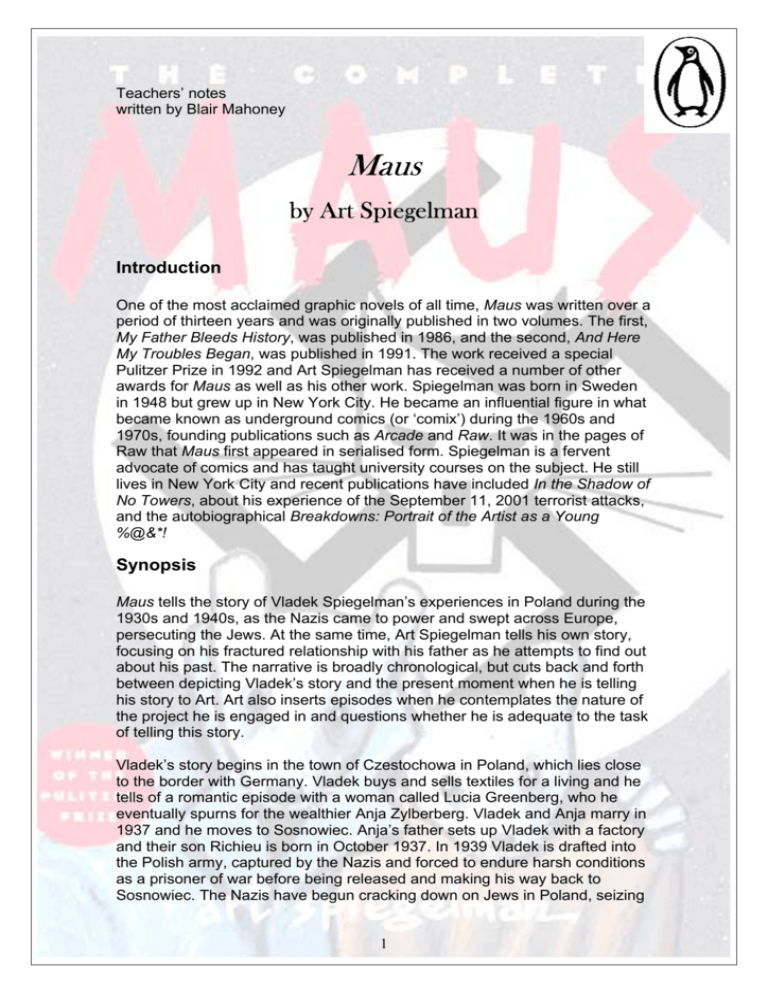
Teachers’ notes written by Blair Mahoney Maus by Art Spiegelman Introduction One of the most acclaimed graphic novels of all time, Maus was written over a period of thirteen years and was originally published in two volumes. The first, My Father Bleeds History, was published in 1986, and the second, And Here My Troubles Began, was published in 1991. The work received a special Pulitzer Prize in 1992 and Art Spiegelman has received a number of other awards for Maus as well as his other work. Spiegelman was born in Sweden in 1948 but grew up in New York City. He became an influential figure in what became known as underground comics (or ‘comix’) during the 1960s and 1970s, founding publications such as Arcade and Raw. It was in the pages of Raw that Maus first appeared in serialised form. Spiegelman is a fervent advocate of comics and has taught university courses on the subject. He still lives in New York City and recent publications have included In the Shadow of No Towers, about his experience of the September 11, 2001 terrorist attacks, and the autobiographical Breakdowns: Portrait of the Artist as a Young %@&*! Synopsis Maus tells the story of Vladek Spiegelman’s experiences in Poland during the 1930s and 1940s, as the Nazis came to power and swept across Europe, persecuting the Jews. At the same time, Art Spiegelman tells his own story, focusing on his fractured relationship with his father as he attempts to find out about his past. The narrative is broadly chronological, but cuts back and forth between depicting Vladek’s story and the present moment when he is telling his story to Art. Art also inserts episodes when he contemplates the nature of the project he is engaged in and questions whether he is adequate to the task of telling this story. Vladek’s story begins in the town of Czestochowa in Poland, which lies close to the border with Germany. Vladek buys and sells textiles for a living and he tells of a romantic episode with a woman called Lucia Greenberg, who he eventually spurns for the wealthier Anja Zylberberg. Vladek and Anja marry in 1937 and he moves to Sosnowiec. Anja’s father sets up Vladek with a factory and their son Richieu is born in October 1937. In 1939 Vladek is drafted into the Polish army, captured by the Nazis and forced to endure harsh conditions as a prisoner of war before being released and making his way back to Sosnowiec. The Nazis have begun cracking down on Jews in Poland, seizing 1 factories, and Vladek is forced to deal in the black market to make a living. The old and weak are already being taken away and sent to Auschwitz. Vladek and Anja’s family are sent to a ghetto in the town of Srodula and Richieu is sent with his aunt to another town they think will be safer, but Tosha kills herself and the children rather than let them go to the gas chambers. The rest of them are forced into hiding but Vladek and Anja are captured when they try to escape to Hungary and they are sent to Auschwitz at the conclusion of Book I of Maus. Book II tells the story of Vladek’s experiences in Auschwitz and what he knows of Anja’s experiences in the accompanying camp, Birkenau. Vladek is able to gain a relatively favourable position by teaching English to his block supervisor. He later gets a position working in the tin shop and then as a shoemaker, each time picking up the skills he needs by carefully observing others. He saves everything he can to arrange bribes for various purposes, including getting Anja transferred to new barracks near his in Auschwitz. When the Russians advance, all of the prisoners are evacuated with many of them dying on trains. Vladek is taken to Dachau, another camp in Germany, where he contracts typhus. The prisoners eventually gain their freedom as the Germans retreat from the Americans, but Vladek still faces a difficult journey back to Sosnowiec to be reunited with Anja. The present day narrative focuses on Art’s interactions with his father and Vladek’s failing health. We learn about Anja’s suicide in 1968, which affected both Art and Vladek greatly. Vladek has remarried, to Mala, another Holocaust survivor, but she grows more and more frustrated with him, eventually leaving him, only to return later. In conversations with his psychiatrist and with his wife Françoise, Art reveals the guilt he feels about the distance he keeps from his father and the success he has had from the publication of the first volume of Maus. The Holocaust ‘Just thinking about my book… it’s so presumptuous of me.’ ‘I mean, I can’t even make any sense out of my relationship with my father… How am I supposed to make any sense out of Auschwitz?... Of the Holocaust?...’ (p. 174) ‘I know this is insane, but I somehow wish I had been in Auschwitz with my parents so I could really know what they lived through! …I guess it’s some kind of guilt about having had an easier life than they did.’ (p. 176) ‘About Auschwitz, nobody can understand.’ (p. 224) The Holocaust looms over everything in any discussion of Maus, and some background information will be necessary for students unfamiliar with the events of the Holocaust. One of the best sources for this information is the United States Holocaust Memorial Museum, which has a wealth of information and resources for teachers and students at its website: http://www.ushmm.org/. A good Australian source is the Jewish Holocaust 2 Centre: http://www.jhc.org.au/. See also the Jewish Museum Berlin (the website is also available in English by clicking on the tab on the front page): http://www.juedisches-museum-berlin.de and the USC Shoah Foundation Institute: http://college.usc.edu/vhi/. Although the word ‘Holocaust’ is used by Spiegelman in Maus, and is the word generally used in English when referring to the attempted extermination of the Jews by the Nazis, the Hebrew word ‘Shoah’, which means ‘calamity’ is preferred by many Jews. In the narrative Art struggles with his attempts to do justice to his father’s story and to make sense of the experiences of the people sent to Auschwitz. He laments to Françoise that he ‘bit off more than [he] can chew’ (p. 176) in attempting to depict the reality of Auschwitz. Art’s psychiatrist, Pavel, points out ‘how many books have already been written about the Holocaust’ and asks, ‘What’s the point? People haven’t changed…’ (p. 205). How successful is Art’s depiction of the Holocaust? How does it compare to other Holocaust narratives such as Elie Wiesel’s Night, or the films Schindler’s List and The Pianist? The graphic novel ‘I mean, reality is too complex for comics… So much has to be left out or distorted’ (p. 176) Many students (and teachers) may be unfamiliar with comics and graphic novels and the particular requirements of reading them. The standard reference for those wishing to understand more about the nuances of the form is Scott McCloud’s Understanding Comics, which itself is written in comic book form. There are many online resources also available, including the website of the National Association of Comics Art Educators: http://www.teachingcomics.org/. The comic book is able to depict the events of the Holocaust in a less confrontational way than photographs or films, especially with the distancing element of the characters being depicted as animals. However, Spiegelman did meticulous research and based his drawings of Auschwitz on photographs and plans. The animal figures drawn very simply are a case of what Scott McCloud calls ‘amplification through simplification’. The original, three-page version of Maus was much more detailed, but by making the figures less explicitly look like mice Spiegelman allows us to project human characteristics onto them and gives them an ‘everyman’ quality. The main difference between studying a graphic novel and a novel is, of course, the pictures. There are some common elements with teaching film as text, and images can be analysed in terms of the composition of the frame as in a film: the use of close-ups or different angles can add meaning to the 3 narrative. One significant difference between graphic novels and films is the element of layout: the arrangement of the frames on the page. Spiegelman often devises quite complex layouts such as on page 14, when Vladek commences telling his story: 4 The image of Vladek riding his exercycle fills several frames, with the final, circular panel representing both the wheel of his exercycle and a portal to the past as he commences his story. Spiegelman also frequently uses maps and diagrams to help depict Vladek’s story, and sometimes elements break free of the confines of the separate frames on each page, such as our first view of the gates of Auschwitz on page 159, or the cascade of Vladek’s family photographs on page 275. When Art depicts an interruption of Vladek’s story and a return to the present, he usually dispenses with a frame to signify the break in chronology. Art complains about how much needs to be left out or distorted, but what does the comic form add to the story that would not have been possible in a novel or autobiography? Structure The structure of Maus can be challenging to follow at times, with the cutting back and forth between the past and the present. There is actually a regular structure to each chapter, however, and the story is told in a chronological way with a few exceptions. Each chapter of Maus begins and ends in the present, usually with Art visiting Vladek, where we get to see more of their strained relationship, and a request from Art for Vladek to tell more of his story. Vladek’s narrative forms the central part of each chapter and is occasionally interrupted with brief returns to the present, usually by Art asking for clarification on some point or other. There are some breaks in the chronology, such as in Chapter 1, when Vladek tells part of his story and then says, ‘Ach! Here I forgot to tell something from before I moved to Sosnowiec but after our engagement was made’ (p. 22). These brief moments could have been rearranged by Art as he composed Maus, but he leaves them in to emphasise the origins of the story in oral history, which is characterised by memory lapses and sometimes unclear connections. Narration and Dialogue Maus has two narrators: Art and Vladek. The narration appears either outside the frames (usually at the top) or in square boxes within the frames. In a few cases a special box holds the narration, such as on page 17, where Vladek’s narration appears on a train ticket stub. Art narrates events in the present, and his narration can be differentiated from Vladek’s because it is in normal sentence case, whereas Vladek’s narration, as with the dialogue, appears all in uppercase. Vladek’s narrative voice is clearly different to Art’s. Although he has lived in the US for many years, his language shows that he is not a native speaker of English. He makes grammatical errors, has unusual word choices and inverts word order, as when he says to Art, ‘But, tell me, how is it by you? How is going the comics business?’ (p. 14). 5 Art keeps his own narration to a minimum, usually just at the beginning of chapters to briefly introduce when and where the action is taking place. He prefers to let the dialogue between himself and his father, or Françoise or Mala convey the way that he feels without adding too much commentary on events. This can be very effective, such as at the end of Book I when he seemingly reconciles with his father and then depicts himself walking away in the final panel repeating the word ‘murderer’ to describe his father’s actions in destroying Anja’s diaries (p. 161). It might have been tempting for an author to add further narration here to justify his shocking comments, but he lets them speak for themselves, even when they paint him in an unflattering light. The dialogue in Maus appears in rounded ‘speech bubbles’, as should be familiar from other comic books. Sometimes the speech bubbles have jagged edges to indicate either a voice on the telephone, as on page 98, or that a character is shouting, as with the ‘old witch’ on page 139. As is usual in comics, the dialogue is written all in uppercase, with the exception of the opening section of Chapter 2 in Maus II, ‘Time Flies’, where Art’s reflective dialogue and then his conversations with the reporters and with Pavel are written in normal sentence case. This is perhaps to separate them more from the main narrative, as they take place after Vladek’s death. Comics and graphic novels are usually more reliant on dialogue than novels are, as there is no need for descriptive narration when the pictures can perform that function. Ideas to Explore Racism ‘The Jews are undoubtedly a race, but they are not human.’ (p. 10) The epigraph from Adolf Hitler that opens Maus is the leaping off point for Art Spiegelman’s decision to portray the Jews as mice in his graphic novel. He is reclaiming the image of Jews as ‘vermin’ from its racist origins and turning it on its head. • What do you think about his decision to portray Jews in this way? • Is he turning the image on its head, or is he unconsciously reproducing the racism of the Nazis? The Nazis are the most obvious proponents of racism in Maus, but the Poles are shown to be just as bad in many instances. Although there are Polish characters who help Vladek and Anja, such as Mrs Motonowa, there are horrible acts committed by other Poles, including, turning Jews over to the Nazis and even murdering Jews themselves, as in the story related by Vladek about Gelber on page 292. Early on, when their Polish governess Janina complains about ‘those Nazis stirring everybody up’, Anja replies, ‘When it comes to Jews, the Poles don’t need much stirring up!’ (p. 39). Art even depicts an incident in America where Vladek is shown to ironically be racist himself. When he suggests that an African American hitch-hiker will inevitably be a thief, Françoise responds, ‘That’s outrageous! How can you, of 6 all people, be such a racist! You talk about blacks the way the Nazis talked about the Jews!’ (p. 259). • What do you make of Vladek’s comments? Is he a racist, and should he know better? Cats and Mice ‘Mickey Mouse is the most miserable ideal ever revealed…’ (p. 164) Art expresses his own concerns about his ‘metaphor’ of drawing Germans as cats and Jews as mice. When he mentions that Pavel’s house is full of stray cats and dogs he adds, ‘Can I mention this, or does it completely louse up my metaphor?’ (p. 203) The metaphor also seems to break down when Vladek and Anja are hiding in Mrs Motonowa’s cellar and Anja is scared by rats while Vladek reassures her that ‘they’re just mice’ (p. 149). But aren’t they supposed to be mice themselves? At the beginning of Maus II, Vladek has an argument with Françoise about how to depict her as a Frenchwoman, and we see sketches of her as a frog and a rabbit (p. 171). All the while, however, we already see her depicted as a mouse. Vladek tells the story of a prisoner in Auschwitz who claims to be German. In side-by-side panels Art depicts him first as a mouse and then as a cat (p. 210). Ultimately, the metaphor is supposed to be suggestive rather than a rigid correspondence between the people and the animals they are depicted as. Mice are the victims of cats, but it doesn’t mean that Jews are always, inevitably victims. • • • Do you think that Art is lumping different people together into essential categories by depicting them in this way? There is perhaps only one ‘good’ cat in Maus. Can you find that character, who appears in just four panels? What do you make of the depiction of Americans as dogs? Why did Art choose that animal? And why did he choose to portray the Poles as pigs? Guilt ‘Maybe EVERYONE has to feel guilty. EVERYONE! FOREVER!’ (p. 202) ‘Maybe your father needed to show that he was always right – that he could always SURVIVE – because he felt GUILTY about surviving.’ (p. 204) ‘Stop! I feel guilty enough already!’ (p. 280) There are a number of sources of guilt in Maus, and a number of people who feel guilty for different reasons. Pavel suggests to Art that maybe Vladek felt guilty about surviving Auschwitz when so many of his friends and family died. He did what he needed to do to survive, but did he do things that could be considered morally questionable? We never find out what prompted Anja to commit suicide. Is it possible that she felt guilty about surviving? Art also feels guilty for several reasons. He clearly feels guilty over the way he treats his father. He finds it difficult to be around him and continually rejects Vladek’s requests to come and live with him. At the beginning of the narrative 7 he says he hasn’t seen him in a long time, even though they both live in New York. The reason he does start seeing him more regularly is because he wants something from him: his story. It is this that leads to another source of guilt for Art. In Maus II he is struggling to deal with the success of the first volume and depicts himself at his drawing desk on a pile of corpses. He feels guilty for being so successful for the story he has told based on the deaths of so many Jews at the hands of the Nazis. Another visual connection he makes in this regard is when he draws the smoke from his cigarette connecting up with the smoke from the smokestacks of Auschwitz. Can you find any examples of this? Photographs ‘It’s spooky, having sibling rivalry with a snapshot!’ (p. 175) Photographs play a large role in the text. Some of them are redrawn by Art with mouse figures instead of humans, but there are also three real photographs reproduced in the text. At the beginning of the inserted comic ‘Prisoner on the Hell Planet’ a hand is drawn holding a real photograph of Anja with Art as a child. A photograph of Richieu is on the dedication page of Maus II and at the end of the book, on page 294 there is a photograph of Vladek. These real photographs disrupt the text and remind us that we are reading accounts of actual people. Photographs can be used to provide documentary evidence of the atrocities that took place, but the photographs used by Art are of his family only. There are also many drawn representations of photographs. A photograph of Anja is present in Art’s room when Vladek begins telling his story on page 14, suggesting that she is something of a spur for him to give his account. Several pages later on page 19 we see a large representation of a photo of Anja, which causes Lucia to feel jealous of the woman who Vladek is preparing to marry instead of her. Pages 274 and 275 are filled with photographs that Vladek has discovered from before the war. As he relates the brief stories of family members who died during the war the photos start to cascade towards the bottom of the page, breaking free of the frames. Photographs are repositories of memories, and the memories are not pleasant for Vladek. Prisoners ‘And we came here to the concentration camp Auschwitz. And we knew that from here we will not come out anymore…’ (p. 159) Aside from the obvious way in which Vladek and Anja and others are prisoners in Auschwitz, there are other suggestions of imprisonment in the text. The first time Vladek is imprisoned is at the beginning of the war, when he is captured in the army. He is freed, but soon discovers that he has very little freedom in Poland now, as the Nazis begin their overt oppression of the Jews, confining them into ghettoes and progressively tightening the noose. When Vladek and Anja escape from the ghetto in Srodula Vladek says, ‘Anja and I didn’t have where to go,’ and they are depicted walking along a road that forms part of a swastika on the landscape (p. 127). They have escaped yet they are still imprisoned, as both the words and the image demonstrate. 8 Art also considers himself a prisoner in some ways, especially in the minicomic ‘Prisoner on the Hell Planet’ where he depicts himself in a concentration camp uniform and locked up behind bars in the final three panels, blaming his mother for putting him there due to her suicide. • Are there any other ways that Art considers himself imprisoned in Maus? Masks ‘I still had on my army uniform, and I didn’t let know I was a Jew’ (p. 66) Maus features many instances of what is known sometimes as ‘passing’, or fitting into a society that has overtly rejected a person because of their racial or religious identity. The first instance we see of this is when Vladek is attempting to return home to Sosnowiec after being a prisoner of war and pretends he is a Pole to the guard on the train. He is depicted ruefully examining a pig mask as he contemplates his deception afterwards (p. 66). Chapter 6 of Book I, ‘Mouse Trap’, features much wearing of masks as Vladek and Anja try to escape detection as they hide from the Nazis. Vladek is confident enough to board trams with high ranking officials and Nazis, however. The ability of Vladek to evade detection in this way undermines the cat/mouse metaphor. In reality Vladek would not have been wearing a mask. He would have been able to escape detection simply because it is impossible to discern a Jew from a Pole or German simply by looking at him or her. This is emphasised when we see the photo of Vladek at the end of the book, and by the photo of Richieu with his blond hair. Another prominent example of passing in a different context can be seen in the film Europa Europa, based on the real-life story of Solomon Perel, who managed to survive the war by posing as a non-Jewish German, even joining the Hitler Youth. Masks are used in a different way in Chapter 2 of Maus II, ‘Time Flies’. Here, Art depicts himself as an ordinary human wearing a mouse mask, pestered by reporters of different nationalities also wearing masks. He visits his psychiatrist, Pavel, another man wearing a mouse mask. This episode encourages us to separate Art Spiegelman the author of Maus from Art Spiegelman the character in Maus. This episode is separate from the main ‘present day’ narrative of Maus, where Art interviews and interacts with his father, so Spiegelman has visually separated it as well. Characters Art ‘I went out to see my Father in Rego Park. I hadn’t seen him in a long time – we weren’t that close.’ (p. 13) Art depicts himself as a distant son who is easily frustrated by his father’s behaviour. The brief anecdote about Art as a child which comes before the beginning of Maus I shows someone who failed to receive appropriate fatherly sympathy after a minor but distressing episode. ‘Prisoner on the Hell Planet’ reveals that Art spent time in a mental hospital as a young adult, suggesting 9 further difficulties that he has faced. He still sees a psychiatrist in the present and has difficulty dealing with feelings of guilt about the way he is ‘cashing in’ on the suffering of Jews in the Holocaust. Art isn’t afraid to depict himself in an unflattering way as a son who is reluctant to help his father, who uses him for his own purposes and even calls him a murderer at the conclusion of Book I. At the same time, the book is a tribute to Vladek and there are clear signs that he does love him. Art is not callous, he does feel guilty and he is wracked by doubt over whether his depiction of his father and his experiences is a fair one. How do you think Art comes across over the course of Maus? Vladek ‘I used to think the war made him that way…’ ponders Art, to which Mala replies, ‘Fah! I went through the camps… All our friends went through the camps. Nobody is like him!’ (p. 133) ‘Maybe Auschwitz made him like that’, says Françoise, but Art responds, ‘Maybe. But lots of people up here are survivors – like those Karps – if they’re whacked up it’s in a different way from Vladek.’ (p. 182) • • How much can we attribute Vladek’s personality to the war and to Auschwitz? The above quotes seem to suggest there is no connection, but is there? Vladek has an abrasive personality, seen in the opening pages when he snaps at Mala over a trivial matter. There are many further instances of those over the course of the book. Art is not the only one to have difficulty getting along with Vladek. Vladek is shown to be very concerned with money in his youth, not considering Lucia Greenberg to be marriage material and rejecting her in favour of the wealthy Anja. There are clear suggestions that he really loved Anja, however, not least when he travels with her to the ‘sanitarium [sic]’ in Czechoslovakia. The same cannot be said of Mala, and all we see of her relationship with Vladek is the constant criticism he directs at her. Vladek is desperate to have Art around, despite his criticisms, and would love to have his son come and live with him, saying ‘To have you with me, it’s always a pleasure. …Remember, my house it’s also your house too.’ (p. 184) During the war Vladek is shown as being more insightful and forward thinking than all of the other characters. His resourcefulness and ability to learn quickly save his life time after time, although luck also plays a role. Anja Anja is a somewhat enigmatic figure in Maus, looming over the story without ever revealing her personality. This is partly because Vladek has destroyed her diaries, which Art desperately wanted to use as a source for his story. In her youth she is described as not as pretty as Lucia, although she is very smart and a wonderful writer. She is physically and mentally frail, however, 10 suffering from a mental breakdown after the birth of Richieu, and expressing a wish to die in several instances during the war. She survives in Birkenau thanks to the assistance of Vladek and Mancie. We never discover her reasons for committing suicide in 1968. Mala Also a Holocaust survivor, Mala knew Vladek and Anja in Poland before the war and has married Vladek after Anja’s death. Continually being criticised by Vladek for trivial things she becomes increasingly frustrated with him and eventually leaves him, only to return to him later. Françoise Art’s wife Françoise appears only in Maus II. We are first introduced to her as Art contemplates how to draw her as a French woman. She understands Art’s frustrations with his father and is equally exasperated by his behaviour, but acts in a more conciliatory manner towards him. Lucia Greenberg Vladek’s lover for three or four years before he meets Anja, Lucia is desperate for him to marry her. The main sticking point appears to be that her family ‘had no money, even for a dowry’ (p. 17). When Vladek leaves her for good she writes a letter to Anja in an attempt to sabotage their relationship. Richieu Art’s brother Richieu tragically died as a child when his aunt gave him and her own child poison instead of letting them be taken to the gas chambers of Auschwitz. Ironically he had been sent away with his aunt to a place that was considered safer. He is depicted as a wilful child, but his death loomed large over his parents’ lives, and they kept a photograph of him in their room. Art dedicates Maus II to him. Father-in-law and mother-in-law (Matka) Anja’s father is a millionaire who lives in luxury in Sosniewic, even after the beginning of the war. He is generous to Vladek, buying him a factory after he marries Anja. He is able to use his wealth to survive until 1943, but even that doesn’t save him and his wife when Vladek’s cousin Haskel accepts their jewels but doesn’t help them escape from the Srodula ghetto. They die in Auschwitz. Wolfe Married to Tosha, Anja’s older sister, Wolfe works for the Gemeinde – the Jewish community organization – and therefore has some influence, but he is overly optimistic about their situation and unwilling to prepare adequately. Wolfe is shot and killed trying to escape from the train to Auschwitz. 11 Tosha Anja’s older sister, Tosha goes with her family and Richieu to Zawiercie when things get bad in the ghetto of Srodula. She poisons herself and the children rather than be taken to Auschwitz when the ghetto is cleared. Ilzecki A tailor, Ilzecki helps Vladek with a note saying he works for him. Has a son the same age as Richieu who survives the war after going to live with a Polish friend, an offer that is extended to Richieu but refused by Anja. Haskel, Pesach and Miloch Spiegelman A cousin described by Vladek as a ‘kombinator’ or crook, Haskel worked for the Jewish police in Srodula and cosied up to the Nazis. He helped Vladek and Anja escape the trains to Auschwitz, but not Anja’s parents. Arranged for the person who showed the Gestapo their bunker to be killed. Survived the war and lived on in Poland. His brother Pesach is also a ‘kombinator’, selling cake made with laundry powder to his fellow Jews amongst other schemes. Another brother, Miloch, is a good person who survives the war, ironically in Vladek’s and Anja’s old hiding place with Mrs Motonowa, and immigrates to Australia, where he dies of a heart attack. Mrs Motonowa A Polish woman who shelters Vladek and Anja in Szopienice after they escape from Srodula, Mrs Motonowa has a smuggling business, dealing in the black market. Anja tutors her son in German, but she insists they leave after she is raided by the Gestapo. They later return and are forced to hide in her rat-infested cellar while her husband is home from his business trips. Mandelbaum An acquaintance of Vladek’s, Mandelbaum attempts to use the people smugglers with Vladek to get into Hungary, but they are deceived by a letter from his nephew Abraham. Goes to Auschwitz with Vladek, where they meet Abraham who reveals he was forced to write the letter after being captured. Vladek looks after Mandelbaum after gaining favour with the ‘Kapo’, but cannot prevent him from being taken away and killed. Pavel Pavel is Art’s psychiatrist, also an Auschwitz survivor, whose house is full of stray dogs and cats. Art says that his ‘sessions with Pavel somehow make [him] feel better’, and we see him growing from a little boy back into a man as he returns home afterwards. 12 Yidl A communist prisoner in charge of the tin shop in Auschwitz, Yidl knows that Vladek was a factory owner before the war and resents him for being a capitalist, but nevertheless protects him when Vladek brings him food. Mancie A Hungarian Jew imprisoned in Birkenau, Mancie is the contact between Vladek and Anja. She has an SS officer lover who gets her a good position with some limited freedom. She passes letters between Vladek and Anja as well as food, risking her own life to do so. Mancie also kept Anja close by after they left Auschwitz, helping her to survive when Vladek was sent to Dachau. Shivek A friend of Vladek’s from before the war, Shivek meets up with Vladek after their release from Dachau at the end of the war. The two of them travel together looking for safety. They go to stay with Shivek’s brother in Hannover, but are separated when they try to get back to Poland. 13
